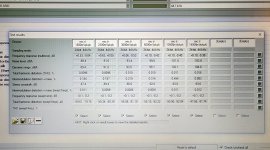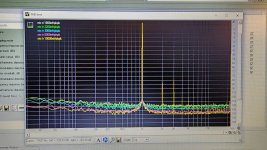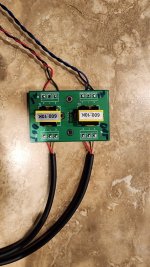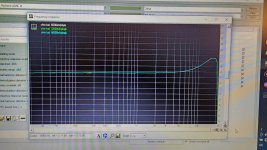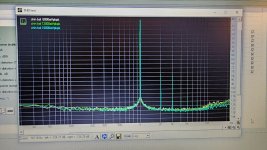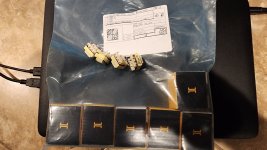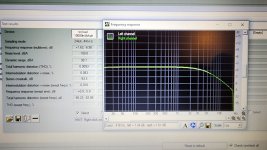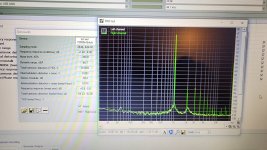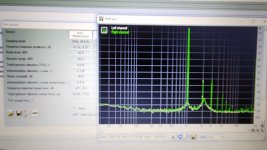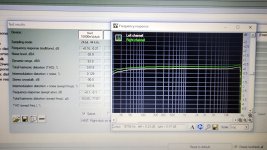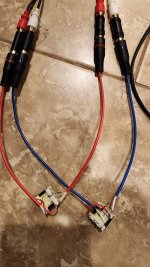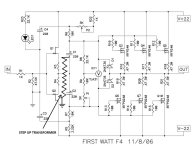Interestingly, i put those edcors in steel enclosures, to shield them, yet they show 60Hz peak, while those two mic balancing trafos have no shield yet are absolutely clean on the bottom. Go figure. Now i know why my prototypes on the floor perform much better than final projects in case.
Here i stop, even i have some other data, enough for one day.
Here i stop, even i have some other data, enough for one day.
I will not start with tubes...but i like your investigation very much!
Well done! please keep going
i tried on my M2 defect edcor audioformer and use the Hammond 109N. still strange for me is the excellent test if i use i with 10k load but in the M2 PCb if got just 36kHz fg.
First sound impression compared to the original Edcor was not bad but i have to learn to listen at 1 channel.
chris
Well done! please keep going
i tried on my M2 defect edcor audioformer and use the Hammond 109N. still strange for me is the excellent test if i use i with 10k load but in the M2 PCb if got just 36kHz fg.
First sound impression compared to the original Edcor was not bad but i have to learn to listen at 1 channel.
chris
Ed,
Do you mind doing an additional experiment when time allows? 🤓
With your Edcor XS4400, connect it conventionally:
BTW, are you loading these transformers with anything but the input impedance of the soundcard? What is the input impedance of the soundcard?
Best,
Anand.
P.S. I would be very curious how this Edcor transformer would perform in an M2 amplifier_it is available in a 1:5 turns ratio.
Do you mind doing an additional experiment when time allows? 🤓
With your Edcor XS4400, connect it conventionally:
- Connect the input signal to Pin 1 (+) and Pin 3 (-), the primary of the transformer.
- Eliminate the connection from Pin 1 to Pin 12.
- Connect Pin 6 to Pin 7, and Pin 9 to Pin 10 (i.e. series connect the secondaries).
- Make Output Pin 4(+) and Pin 12 (-).
BTW, are you loading these transformers with anything but the input impedance of the soundcard? What is the input impedance of the soundcard?
Best,
Anand.
P.S. I would be very curious how this Edcor transformer would perform in an M2 amplifier_it is available in a 1:5 turns ratio.
Last edited:
Hi Anand, not loading transformers, just input to focusrite scarlet.
Yes, i can do the test, will report back.
I can order transformer you linked. But it will take some time to deliver.
Yes, i can do the test, will report back.
I can order transformer you linked. But it will take some time to deliver.
What is the value of the output capacitor on the Aikido CF?Made some more experiments. Surprisingly, stepup edcor does not work well with aikido tube buffer. Not sure what is the reason. Aikido itself as buffer measures well and sounds clean. But aikido feeding edcors has terrible rollof on low frequencies. No bass. Must be some incompatibility.
I have an Aikido CF (6N1P) with 8.2uF Mundorf EVO Oil at the output. The impedance of the capacitor is 970 ohms at 20 Hz plus a few hundred ohms from the buffer itself. It only increases at lower frequencies. Together, everything is over 1k2 at 20Hz, and that is not a small enough impedance to put a transformer on the output.
I will check the aikido buffer, but its likely in attic somewhere. Yes, there sure is simple reason for rolloff.
These days i am driving edcor step up transformers with opa604 and it works great.
These days i am driving edcor step up transformers with opa604 and it works great.
Anything made from transistors with a low output impedance is better. As soon as you have to put a capacitor on the output, forget about the transformer. Usually AVC is taken instead of a potentiometer, then a buffer behind it. Then it makes sense to put Aikido CF or whatever to buffer the AVC. And some samples really sound great, I have had contact with a few pieces of such preamps. Some don't really sound like anything special, and they aren't cheap.
I am satisfied with Aikido. I made a preamp and several CF buffers. Tried E88CC, 6922, 6N6P, 6N23P, 6N1P, 6N23P, 6N3P, 5670 & 6CC42. I might switch to Octal now.
Well, its so ugly outside that i decided to do some more work on big edcor. Instead of autoformer, i simply wired it as transformer. It has four identical coils, so one can do pretty much anything. Used the same coil on input, and three other coils in series for output. Separate grounds, not that its any groundbreaking stuff. This perfectly fixed the low frequencies, ruller flat bottom. However, top rollof is still there, 9dB at 20kHz. Measured very low THD, 0.009% at 10Vpkpk output, very clean. Required ~3.2Vpkpk input for that. Nice decresing harmonics. Surprisigly no 60Hz polution, nice clean -130dB noise, no hum. Breaking ground, or removing cover helped.
Unfortunately highs rolloff is nature of the core, does not depend on wireing. Still can be used if eq is applied.
Unfortunately highs rolloff is nature of the core, does not depend on wireing. Still can be used if eq is applied.
Attachments
Interesting - I’m glad you wired it like I mentioned in post 47 (I have no idea how you wired it for the bandpass response you posted after that though!). So the bottom is flat which is good. But top end is STILL rolled off?? 9dB down at 20khz, not good! Can you ask Edcor what is going on and how we need to wire it for flatness at 20khz? Perhaps its due to the interleaving winding nature of this design. Of course, they don’t publish measurements like they did with Mx5cs series. That would be nice to see and to clarify. The Mx5cs looks flat as a pancake.Well, its so ugly outside that i decided to do some more work on big edcor. Instead of autoformer, i simply wired it as transformer. It has four identical coils, so one can do pretty much anything. Used the same coil on input, and three other coils in series for output. Separate grounds, not that its any groundbreaking stuff. This perfectly fixed the low frequencies, ruller flat bottom. However, top rollof is still there, 9dB at 20kHz. Measured very low THD, 0.009% at 10Vpkpk output, very clean. Required ~3.2Vpkpk input for that. Nice decresing harmonics. Surprisigly no 60Hz polution, nice clean -130dB noise, no hum. Breaking ground, or removing cover helped.
Unfortunately highs rolloff is nature of the core, does not depend on wireing. Still can be used if eq is applied.
Thanks for all your hard work!!
P.S. Another thought is to wire all the secondaries of the XS4400 in parallel and check the FR. Pins 4,7,10 together are (+) and Pins 6,9,12 together are (-).
Best,
Anand.
Last edited:
Down by 5dB @ 10khz. No flat response in sight. I wonder if this is intrinsic to this XS4400 transformer design. You’ve measured it as an autoformer as well as a conventional transformer both with secondaries in series then in parallel, all with the same result.
I’m very glad you are measuring though. Or else, how would you have known?!
Best,
Anand.
I’m very glad you are measuring though. Or else, how would you have known?!
Best,
Anand.
And now for that small audio transformer Triad.
Its not mic transformer, its an isolation transformer, or balancing transformer, with four identical coils. I serially connected each two on each side. Both sides are likely 10k ohm, but i did not bother with dats3.
Resistance is identical. I wired all coils in series as autoformer. Measured at 10Vpkpk output, applied about 5Vpkpk in the middle. It provides respectable 0.016% thd, nice fr response, just tiny lift up, ok spectra. Can be used as isolation transformer, or balancing, or even as 2x gain step up transformer. Lots of posibilities.
Its not mic transformer, its an isolation transformer, or balancing transformer, with four identical coils. I serially connected each two on each side. Both sides are likely 10k ohm, but i did not bother with dats3.
Resistance is identical. I wired all coils in series as autoformer. Measured at 10Vpkpk output, applied about 5Vpkpk in the middle. It provides respectable 0.016% thd, nice fr response, just tiny lift up, ok spectra. Can be used as isolation transformer, or balancing, or even as 2x gain step up transformer. Lots of posibilities.
Attachments
- Home
- Source & Line
- Analog Line Level
- Tube buffered transformer volume control (TVC)
